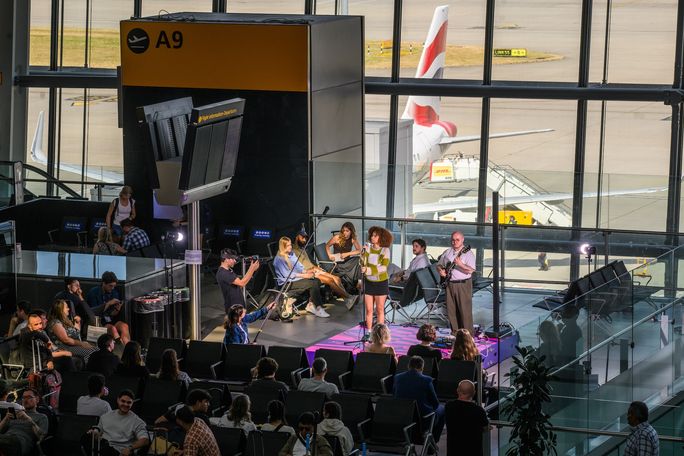
Changing planes is a necessity for millions of airline
passengers every year. When it comes time to book flights, however,
international travelers in particular may find flight options that lead to a
question: Is it better to make a connection at a U.S. airport or abroad?
The answer, according to multiple travel experts, is
that it depends. Making an international connection at a U.S. airport may seem
like the most logical choice, especially for people flying from smaller
domestic cities. But savvy travelers and travel advisors can often expand their
options, and perhaps even improve their itinerary, by taking a look at what the
airline industry calls “sixth-freedom” routes, which allow a carrier
to transport passengers between two foreign countries via a connection in the airline’s
home nation.
In other words, you could fly from Denver to
Johannesburg via London, England, rather than Atlanta.
A variety of factors — including route logistics,
airfare, airline loyalty membership and overall quality of the experience — can
influence a traveler’s ultimate decision about where to catch that next flight.
Here’s what to keep in mind.
The Advantages of U.S. Connections
For many U.S.-based globetrotters, connecting on their
own home turf offers clear benefits.
“U.S. connections often provide easier re-routing,
status perks and greater reliability for time-sensitive itineraries,” said
Helene Quick, corporate aviation specialist and luxury travel advisor at Quick Aloha Travel Services, an Affluent
Traveler Collection affiliate in Las Vegas. “For high-frequency corporate
travelers or loyalty-driven flyers, staying within the U.S. often ensures
faster re-accommodation, familiar security protocols and optimized mileage
accrual.”
Jason Block, CEO of WorldVia Travel Group, agrees. “A
domestic connection in the U.S. often means a more streamlined experience upon
returning, as you’ll clear customs and immigration at your first point of
entry,” he said. “This can be less stressful than navigating these
procedures in a foreign country after a long-haul flight. Additionally, U.S.
hubs often provide more flight frequencies and options to a wider range of
domestic connections, which can be a significant advantage if your final
destination is a smaller city.”
Joy Crutchfield, founder and owner of The Joy of Travel, a TRAVELSAVERS affiliate in
Oklahoma City, also lists several advantages. “It makes the most sense to
connect within the USA when you can catch a nonstop flight from that hub to
your final destination,” she said. “There’s nothing quite like the
ease and peace of mind of boarding once and flying straight through after your
connection.”
In terms of efficiency, advisors praised several U.S.
airports — including those serving Dallas-Fort Worth, Atlanta,
Minneapolis-Saint Paul and Seattle — for their ease of use for
domestic-international transitions.
The Appeal of the International Layover
Changing planes in another country can also offer an
array of advantages. One of the biggest, according to Quick, is comfort,
especially when flying in the front of the cabin. “For international
[trips] where comfort, service and exclusivity matter, connecting abroad can
elevate the entire experience,” she said. “Global hubs like
Singapore, Doha and Istanbul offer superior lounges, luxury concierge services
and elite treatment for business and first-class travelers.”
Indeed, several non-U.S. airports offer spectacular
facilities, with an array of onsite activities and attractions, as well as
sumptuous lounges that can make layovers more pleasant. In addition, some
foreign airlines may offer superior in-flight service, even in economy class,
when compared to their U.S. competitors.
Block agrees about the appeal of foreign connections.
“Some international hubs are destinations in themselves, offering
incredible amenities,” he said. “The real game-changer, however, is
the opportunity for a stopover, sometimes at no additional airfare, which a
knowledgeable travel advisor can help arrange. This essentially allows for two
trips in one.”
Block praised stopover programs offered by Icelandair, Turkish Airlines, Qatar Airways and Etihad Airways — all of which make it possible
to explore an additional country during a layover without adding much time or
cost to the original itinerary.

Live entertainment at Heathrow. (Photo Credit: Heathrow Airports Limited)
Practical Considerations
There are several factors that travelers should weigh
when considering a sixth-freedom connection in another country.
One of the most critical issues is customs and
immigration. “Typically, you’ll only go through customs and immigration at
your final destination or upon re-entering the U.S.,” said Crutchfield.
“However, there are exceptions, depending on the country and airport, so
check the specifics for your connection.”
Block added that transit visas may occasionally be
required, as well. “It’s crucial to be aware of any potential transit visa
requirements, which can vary based on your nationality and the connecting
country,” he said. “A travel advisor will be well-versed in these
nuances and can ensure you have the proper documentation and sufficient
connection time.”
Quick recommends researching various details about
connecting airports. “Always confirm visa requirements, minimum connection
times and terminal layouts,” she advised. “Delays or immigration
bottlenecks can derail tightly scheduled itineraries, especially for travelers
coordinating with crew rotations or onward private charters.”
To that end, Crutchfield says she never books flights
with less than a three-hour connection time when it’s an international airport.
“This is critical,” she said. “Major international airports can
be complex and busy. Research your connection airport’s layout and transfer
procedures to avoid surprises and make your transit smoother.’
That type of advice can also apply to connections in
the United States, as some U.S. airports are notorious for slow customs and
immigration processing, or have layouts that require extra transit time between
gates.
“Whether you’re changing planes in a U.S. hub or a
bustling international airport, the biggest challenges often boil down to the
same culprits: large airports, tight connection windows and unavoidable
delays,” Crutchfield said.
“Here’s the bright side: knowing this levels the
playing field,” she added. “Don’t shy away from international
connections just because they sound intimidating. Instead, plan wisely.”
For the latest travel news, updates and deals, subscribe to the daily TravelPulse newsletter.

